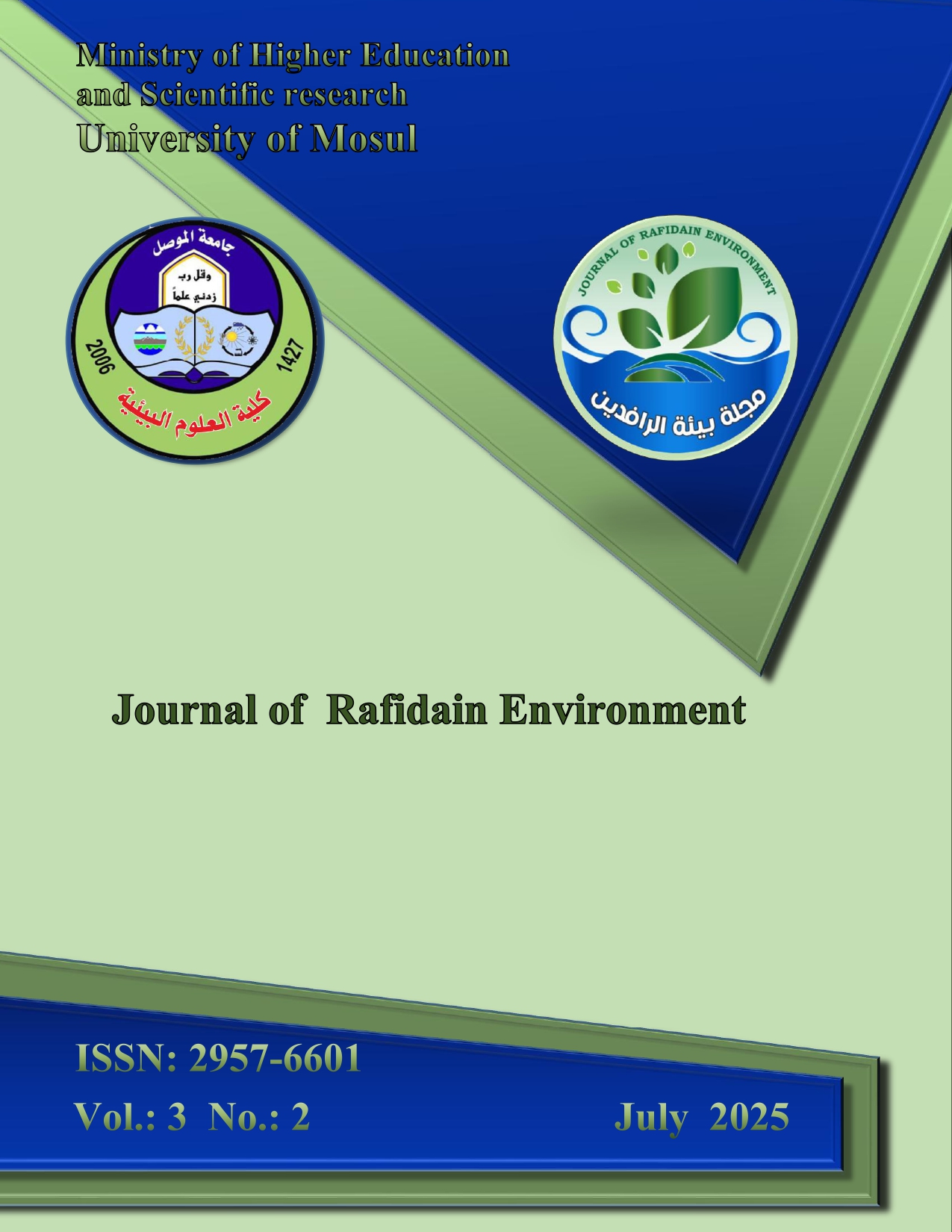Evaluation of some bioremediation applications of Tannase enzyme purified from ascomycete fungus Helvella bachu

Published
Oct 6, 2025Pages
78-87Abstract
With the aim of reducing or stopping the threats to ecosystems, the current study was designed to investigate the ability of the tannase enzyme purified from the local isolate of ascomycete fungus Helvella bachu in reducing the most dangerous toxin aflatoxin B1, using high-performance liquid chromatography technique, aflatoxin B1concentration was reduced to 3.4 ng/ml. Tannase enzyme analyzed the aflatoxin into two compounds in terms of the appearance of two peaks at a retention time 2.08 minutes and 4.59 minutes, with a residual area percentage 13.8 and 86.6% respectively, compared to standard aflatoxin, which appeared with one peak at a retention time 4.79 minutes. The concentration of aflatoxin decreased to 1.2 ng/ml using the crude enzyme compared to aflatoxin before treatment 1.32 µg/ml at the same retention times for the purified enzyme with a difference in the remaining area 45.8 and 54.2% respectively. Moreover tannase enzyme analyzed the aflatoxin into two new compounds . The ability of tannase enzyme to remove a number of industrial dyes was also evaluated in a period of time ranging from (6-48) hours, the results showed that the enzyme was able to remove 100% of the dyes: Reactive Yellow, Indigo Carmina, and Orange G. but with varying percentages of the other dyes used after 48 hours of enzyme treatment.
The aim of this study was investigate the ability of the purified tannase enzyme from the ascomycete fungus Helvella bachu to treat aflatoxin B1 and number of industrial dyes.
References
- Abdel-Shafy, H. I., & Mansour, M. S. (2016). A review on polycyclic aromatic hydrocarbons: source, environmental impact, effect on human health and remediation. Egyptian journal of petroleum, 25(1), 107-123.
- Albuquerque, K. K., Albuquerque, W. W., Costa, R. M., Batista, J. M. S., Marques, D. A., Bezerra, R. P., Herculano, P.N. & Porto, A. L. (2020). Biotechnological potential of a novel tannase-acyl hydrolase from Aspergillus sydowii using waste coir residue: Aqueous two-phase system and chromatographic techniques. Biocatalysis and Agricultural Biotechnology, 23, 101453.
- Al-rawi, J. M. & Abdul-Hadi, S.Y. (2022). Purification and Characterization of Tannase from New Local Isolate Fungus Helvella bachu and its Application to Remove Stains from Cotton Fabrics. International Journal of Special Education, 37(3),16149- 16163.
- Al-Rawi, J. M., & Abdul-Hadi, S. Y. (2022). First new record and molecular identification of Helvella bachu (Ascomycetes) isolated from Iraq/Mosul. International Journal for Research in Applied Sciences and Biotechnology, 9(3), 143-148.
- Alberts, J. F., Engelbrecht, Y., Steyn, P. S., Holzapfel, W. H., & Van Zyl, W. H. (2006). Biological degradation of aflatoxin B1 by Rhodococcus erythropolis cultures. International journal of food microbiology, 109(1-2), 121-126.
- Alberts, J. F., Gelderblom, W. C. A., Botha, A., & Van Zyl, W. H. (2009). Degradation of aflatoxin B1 by fungal laccase enzymes. International journal of food microbiology, 135(1), 47-52.
- Ado, B. V., Onilude, A. A., Oluma, H. O. A., & Mabitine, D. M. (2019). Production of fungal laccase under solid state bioprocessing of agroindustrial waste and its application in decolourization of synthetic dyes. Journal of Advances in Biology & Biotechnology, 4, 1-17.
- Abd-Elmotey, S., Nasar, F. R., Nasar, S. A., & Abou-Taleb, K. A. (2022). Tannase and gallic acid production by Aspergillus niger SWP33 and Penicillium griseoroseum T11 using agricultural wastes under submerged and solid-state fermentation and its application. Egyptian Journal of Chemistry, 65(9), 21-35.
- Atlas, R. M. (1998). Pathogenesis of Infection Diseases. Principles of Microbiology. 1st ed. Louis: Mosby-Yearbook, Inc.
- Branà, M. T., Sergio, L., Haidukowski, M., Logrieco, A. F., & Altomare, C. (2020). Degradation of aflatoxin B1 by a sustainable enzymatic extract from spent mushroom substrate of Pleurotus eryngii. Toxins, 12(1), 49.
- Rana, R. (2016). Studies on growth conditions of wild edible mushroom Helvella crispa fries selected from north west Himalayan region. Int J Curr Res, 8(9), 38079-38085.
- Muslim, S. N., Mahammed, A. N., & Al-kadmy, I. M. S. (2015). Detoxification of zearalenone produced by Fusarium graminearum by purified tannase from Citrobacter freundii. Greener Journal of Biochemistry and Biotechnology, 2(1), 001-008.
- Shome, R. (2020). Role of microbial enzymes in Bioremediation. ELifePress, 1(1), 15-20.
- de Sena, A. R., Dos Santos, A. C. D. B., Gouveia, M. J., de Mello, M. R. F., Leite, T. C. C., Moreira, K. A., & de Assis, S. A. (2014). Production, characterization and application of a thermostable tannase from Pestalotiopsis guepinii URM 7114. Food Technology and Biotechnology, 52(4), 459.
- Tomer, A., Singh, R., Singh, S. K., Dwivedi, S. A., Reddy, C. U., Keloth, M. R. A., & Rachel, R. (2021). Role of fungi in bioremediation and environmental sustainability. Mycoremediation and Environmental Sustainability: Volume 3, 187-200.
- Yehia, R. S. (2014). Aflatoxin detoxification by manganese peroxidase purified from Pleurotus ostreatus. Brazilian Journal of Microbiology, 45, 127-134.
- Vaksmaa, A., Guerrero-Cruz, S., Ghosh, P., Zeghal, E., Hernando-Morales, V., & Niemann, H. (2023). Role of fungi in bioremediation of emerging pollutants. Frontiers in Marine Science, 10, 1070905. https://doi.org/10.3389/fmars.2023.1070905
Identifiers
Download this PDF file
Statistics
Copyright and Licensing

This work is licensed under a Creative Commons Attribution-NonCommercial 4.0 International License.